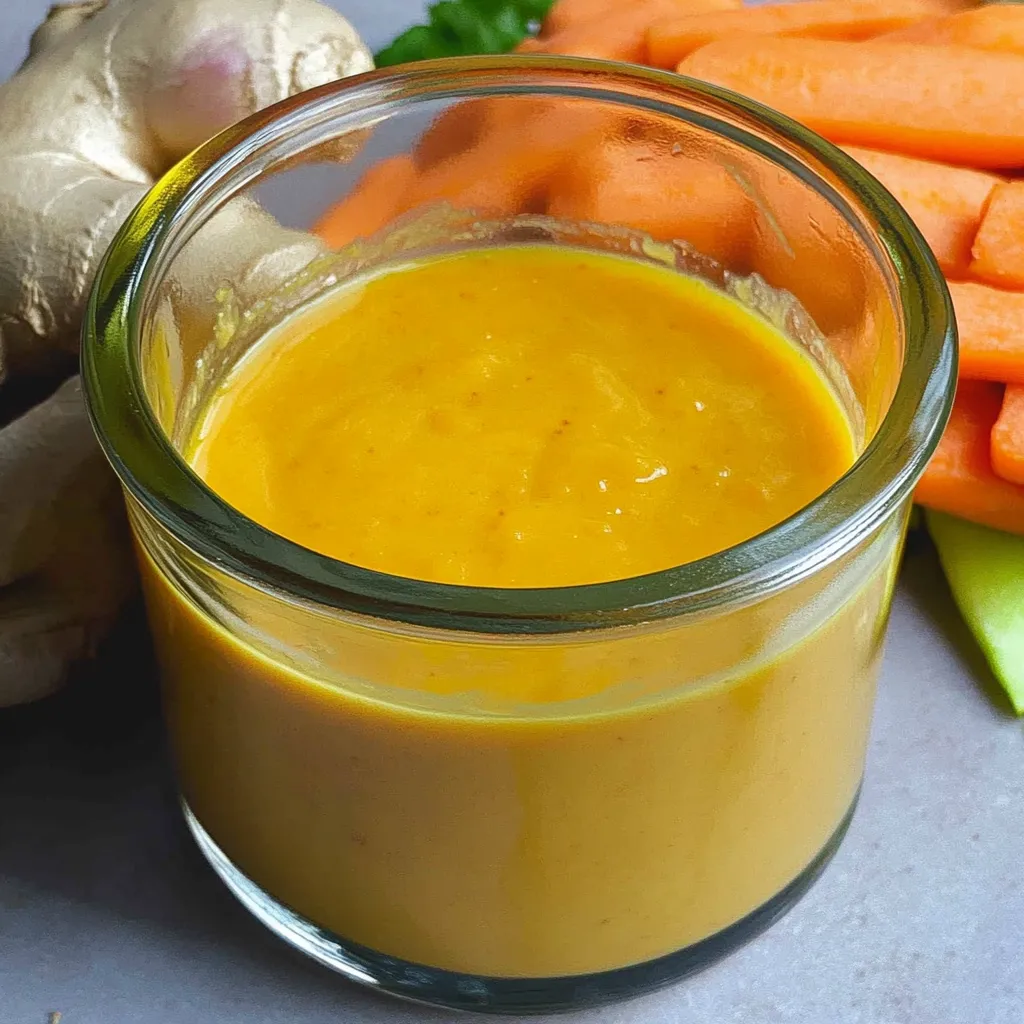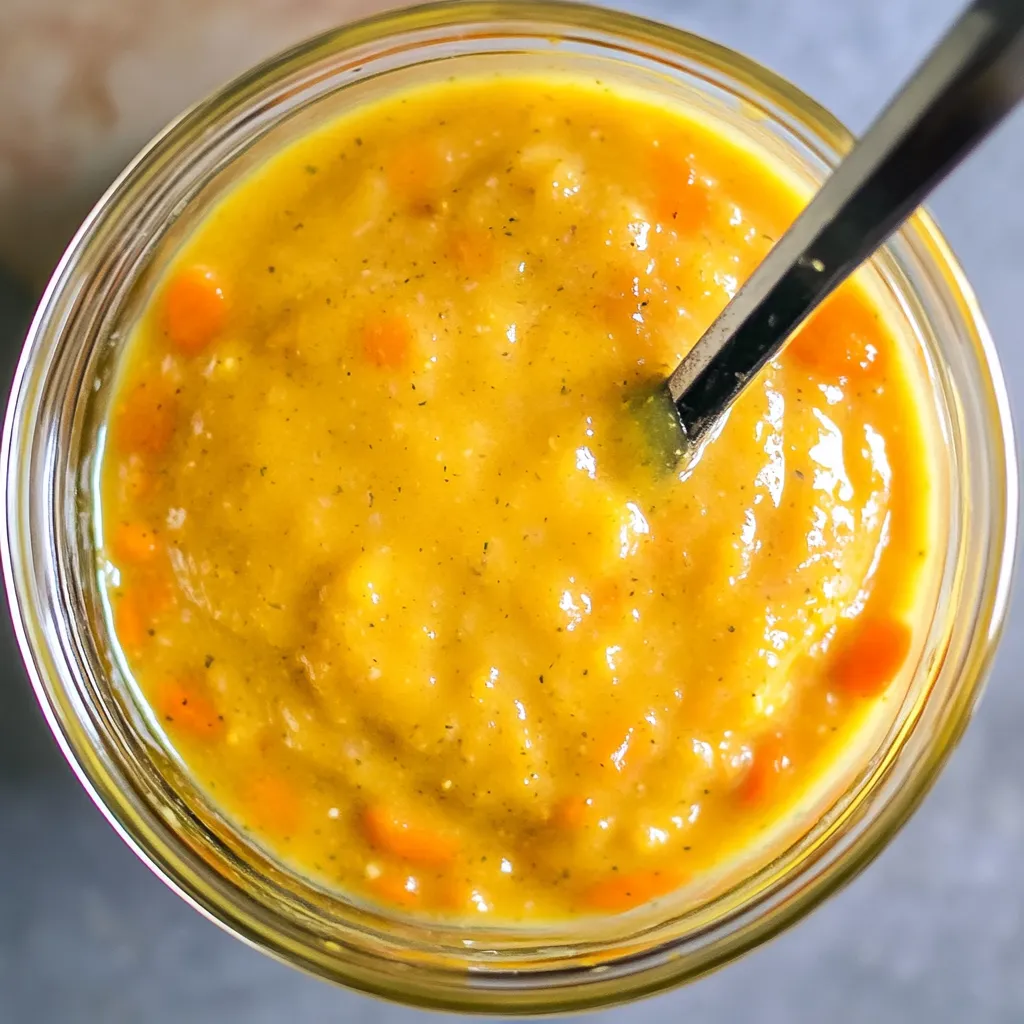 Pin it
Pin it
Japanese Ginger Salad Dressing brings that distinctive restaurant-quality flavor right to your home kitchen with just a handful of fresh ingredients and a quick blend in the food processor. This vibrant, creamy orange dressing combines the warming heat of fresh ginger with the natural sweetness of carrots and a perfect balance of soy sauce and rice vinegar. It's the same addictive dressing you get at Japanese steakhouses and hibachi restaurants - smooth, tangy, slightly sweet, and with that unmistakable ginger kick that makes you want to drizzle it on everything.
I've been making this dressing for years after getting tired of buying expensive bottles of Japanese dressing that never quite tasted as good as what I remembered from restaurants. The first time I made it, I was amazed at how that distinctive creamy orange color and complex flavor came together so easily. Now I always keep a jar in my refrigerator because it transforms even the most basic green salad into something special.
Ingredients and Why Each One Matters
- Fresh ginger root: This is absolutely the star ingredient that gives the dressing its signature warming heat and aromatic quality; fresh ginger has a brightness and complexity that powdered ginger simply can't match
- Carrots: These provide natural sweetness and create that beautiful orange color that makes the dressing so visually appealing; they also add body and help emulsify everything together
- Onion (white or red): Adds a subtle sharpness and depth of flavor that balances the sweetness of the carrots; you can use shallots or green onions if you prefer a milder taste
- Granulated sugar: The fine crystals dissolve quickly and provide the perfect amount of sweetness to balance the tangy vinegar and salty soy sauce
- Soy sauce: Forms the umami base of the dressing and adds that essential salty-savory element; use low-sodium if you prefer to control the salt level
- Rice vinegar: Provides the bright acidity that makes this dressing so refreshing; it's milder than other vinegars and has a slight sweetness that works perfectly with Asian flavors
- Neutral oil (vegetable, avocado, or peanut): Creates the smooth, creamy texture and helps all the flavors blend together; you can add a tablespoon of sesame oil for extra Asian flavor
When selecting your ginger, look for pieces that feel firm and heavy with smooth, tight skin. Avoid any that feel soft or have wrinkled skin, as these are past their prime. For the carrots, choose ones that are bright orange and firm - baby carrots work perfectly and don't even need peeling.
Step-by-Step Instructions
- Prepare all your fresh ingredients:
- Start by peeling the ginger root using the edge of a spoon, which works much better than a knife for getting around all the curves and knobs. Peel your carrots with a vegetable peeler, and peel your onion, removing any papery outer layers. Don't worry about perfect chopping since everything's going in the food processor - just rough pieces that will fit easily into your machine.
- Roughly chop everything for easier blending:
- Cut the ginger into small chunks about the size of your thumbnail - this helps your food processor blend it smoothly without leaving fibrous pieces. Chop the carrots into 1-inch pieces, and cut the onion into quarters. Having everything roughly the same size ensures even blending and prevents some pieces from being over-processed while others remain chunky.
- Add all ingredients to your food processor:
- Place the chopped ginger, carrots, and onion into your food processor first, followed by the sugar, soy sauce, rice vinegar, and oil. Adding the harder vegetables first and the liquids last helps create better circulation during blending and prevents the liquids from just spinning around without incorporating the solids.
- Blend until completely smooth:
- Process everything for 60-90 seconds until the mixture is completely smooth and has that characteristic creamy orange color. Stop once or twice to scrape down the sides with a spatula to ensure everything gets incorporated. The finished dressing should be smooth with no visible chunks of ginger or carrot, and it should have a pourable but not too thin consistency.
- Taste and adjust the flavors:
- Give the dressing a taste and adjust as needed - add more soy sauce if you want it saltier, more vinegar for extra tang, or more sugar if it needs sweetness. The beauty of making your own is that you can customize it exactly to your taste preferences. Remember that the flavors will meld and develop even more after it sits for a while.
 Pin it
Pin it
This dressing has become my secret weapon for making everyday salads feel special. I love how it transforms a simple mix of greens into something that tastes like it came from an upscale Japanese restaurant. The combination of sweet, salty, tangy, and spicy flavors hits all the right notes, and that beautiful orange color makes everything look more appetizing.
What I find most impressive about this recipe is how the carrots work double duty - they provide natural sweetness that reduces the need for excess sugar, and they create that gorgeous color that makes the dressing so visually appealing. It's much healthier than store-bought versions that often contain artificial colors and preservatives.
The texture is absolutely perfect - creamy enough to coat salad leaves beautifully, but not so thick that it overwhelms delicate greens. I've served this to friends who insist it tastes exactly like what they get at their favorite Japanese restaurants, which always makes me feel like a kitchen genius.
Storage is incredibly simple with this dressing. I keep mine in a mason jar in the refrigerator, and it stays fresh for up to four days. The natural separation that occurs is completely normal - just give it a good shake before using and it comes right back together.
I've experimented with different variations over the years, sometimes adding a touch of sesame oil for extra depth, or using honey instead of sugar for a more complex sweetness. But honestly, the basic recipe is so perfectly balanced that I rarely stray from it.
Uses Beyond Salad
This versatile dressing works beautifully as a marinade for chicken thighs or salmon fillets - the acid from the vinegar helps tenderize the protein while the ginger adds incredible flavor. I've also used it as a sauce for grilled vegetables, mixed it into cold noodle salads, and even used it as a dipping sauce for spring rolls or dumplings.
For meal prep, I love making a big batch on Sunday and using it throughout the week in different ways. Monday might be a simple green salad, Tuesday could be marinated grilled chicken, and Wednesday might be a grain bowl with roasted vegetables - all unified by this incredible dressing.
This Japanese Ginger Salad Dressing has honestly revolutionized how I think about salads. Instead of dreading the same old lettuce and tomatoes, I actually look forward to trying this dressing on different combinations of vegetables and proteins. It's one of those recipes that makes you feel like a more sophisticated cook while being incredibly simple to execute - exactly the kind of recipe that earns a permanent spot in any home cook's repertoire.
Frequently Asked Questions
- → How long does this ginger dressing last in the fridge?
- The dressing stays fresh in the refrigerator for up to one week when stored in an airtight container.
- → Can I make this dressing without a food processor?
- You need either a food processor or blender to get the smooth texture. A regular whisk won't work for this recipe.
- → What type of oil works best for this recipe?
- Vegetable oil, peanut oil, or avocado oil all work great. Choose based on your preference and dietary needs.
- → Is this dressing actually vegan?
- Yes, all ingredients are plant-based. Just make sure your soy sauce doesn't contain any fish ingredients if you're strictly vegan.
- → Why is my ginger dressing too thick?
- Simply add a little water, one tablespoon at a time, until you reach your desired consistency. This happens sometimes with different vegetable sizes.
- → Can I freeze this ginger dressing?
- Yes, you can freeze it for up to one month. Thaw in the fridge and give it a good shake before using.
- → What's the easiest way to peel fresh ginger?
- Use a spoon to scrape off the skin. It's much easier than using a knife and wastes less of the ginger.
